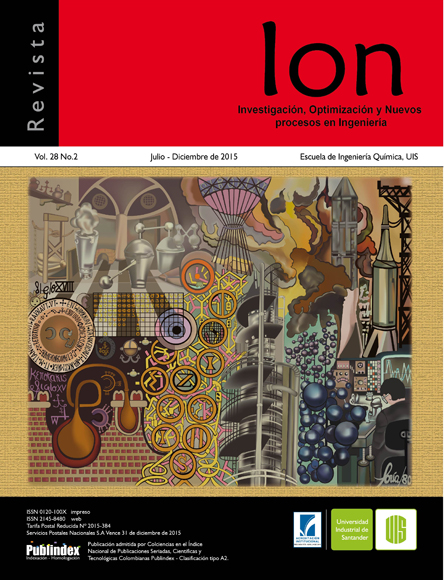Articles
Xanthan gum production by X. Campestris ATCC 13951 using deproteinated cheese whey
Published 2015-12-30
Keywords
- Xanthan Gum,
- Milk Whey,
- Xanthomonas Campestris.
How to Cite
Sobenes G., J., & Alegre, R. M. (2015). Xanthan gum production by X. Campestris ATCC 13951 using deproteinated cheese whey. Revista ION, 28(2). https://doi.org/10.18273/revion.v28n2-2015006
Abstract
Xantan gum is a biopolimer produced by bacteria from the generous Xantomonas. The objective of this work was to study the xantan gum production using the X. campestris ATCC 13591 and deproteined cheese whey, deproteined cheese whey supplemented with yeast extract and deproteined cheese whey supplemente with yeast extract and ammonium sulphate as nitrogen source during 72 hours of fermentation. The best result was found when the medium was not supplemented, reaching yield of 58% and good quality of the gum.
Downloads
Download data is not yet available.
References
[1] De Vuyst L, Vermeire A. Use of industrial medium components for xanthan production by Xanthomonas campestris NRRL-B-1459. Appl Microbiol Biotechnol. 1994;42(2/3):187-91.
[2] Funahashi H, Yoshida T, Taguchi H. Effect of glucose concentrations on xanthan gum production by xanthomonas campestris. J. Ferment. Technol. 1987;65(5):603-6.
[3] Garcı́a Ochoa F, Santos VE, Casas JA, Gómez E. Xanthan gum: production, recovery, and properties. Biotechnology Advances. 2000;18(7):549-79.
[4] Jansson PE, Kenne L, Lindberg B. Structure of the extracellular polysaccharide from xanthomonas campestris. Carbohydr Res. 1975;45(1):275-82.
[5] Nitschke M, Rodrigues V, Schinatto LF. Formulação de meios de cultivo a base de soro de leite para a produção de goma xantana por X. campestris C7L1. Ciênc. Tecnol. Aliment. 2001;21(1):82-5.
[6] Nussinovitch A. Hydrocolloid applications: gum technology in the food and other industries. U.S.A: Blackie Academic & Professional; 1997.
[7] Palaniraj A, Jayaraman V. Production, recovery and applications of xanthan gum by Xanthomonas campestris. J. Food Eng. 2011;106(1):1-12.
[8] Papagianni M, Psomas SK, Batsilas L, Paras SV, Kyriakidis DA, Liakopoulou-Kyriakides M. Xanthan production by Xanthomonas campestris in batch cultures. Process Biochemistry. 2001;37(1):73-80.
[9] Rehm BHA. Bacterial polymers: biosynthesis, modifications and applications. Nature Reviews Microbiology. 2010;8(8):578-92.
[10] Rosalam S, England R. Review of xanthan gum production from unmodified starches by Xanthomonas comprestris sp. Enzyme and Microbial Technology. 2006;39(2):197-207.
[11] Savvides AL, Katsifas EA, Hatzinikolaou DG. Xanthan production using whey permeate medium. World J Microbiol Biotechnol. 2012;28:2759-64.
[12] Silva MF, Treichel H. Aproveitamento de soro de leite para produção de polissacsrídeos. Vivências – Erechim. 2006;1(3):1-4.
[13] Sloneker JH, Jeanes A. Exocellular bacterial polysaccharide from Xanthomonas campestris NRRL B-1459: Part I. Constitution. Can. J. Chem. 2013;40(11):2066-71.
[14] Souw P, Demain AL. Nutritional Studies on Xanthan Production by Xanthomonas campestris NRRL B1459. Applied and Environmental Microbiology.1979;37(6):1186-92.
[15] Sutherland IW. Biotechnology of Microbial Polysaccharides in Food. In: Food Biotechnology. Shetty K, Paliyath G, Pometto A, Levin RE. Editores. CRC Press; 2005.
[16] Waites MJ. Industrial microbiology: an introduction. U.S.A: Blackwell Science; 2001.
[17] Whistler RL, Bemiller JN. Industrial gums: polysaccharides and their derivatives. 3rd ed. U.S.A: Academic Press; 1993.
[18] Wyatt NB, Liberatore MW. Rheology and viscosity scaling of the polyelectrolyte xanthan gum. J Appl Polym Sci. 2009;114(6):4076-84.
[2] Funahashi H, Yoshida T, Taguchi H. Effect of glucose concentrations on xanthan gum production by xanthomonas campestris. J. Ferment. Technol. 1987;65(5):603-6.
[3] Garcı́a Ochoa F, Santos VE, Casas JA, Gómez E. Xanthan gum: production, recovery, and properties. Biotechnology Advances. 2000;18(7):549-79.
[4] Jansson PE, Kenne L, Lindberg B. Structure of the extracellular polysaccharide from xanthomonas campestris. Carbohydr Res. 1975;45(1):275-82.
[5] Nitschke M, Rodrigues V, Schinatto LF. Formulação de meios de cultivo a base de soro de leite para a produção de goma xantana por X. campestris C7L1. Ciênc. Tecnol. Aliment. 2001;21(1):82-5.
[6] Nussinovitch A. Hydrocolloid applications: gum technology in the food and other industries. U.S.A: Blackie Academic & Professional; 1997.
[7] Palaniraj A, Jayaraman V. Production, recovery and applications of xanthan gum by Xanthomonas campestris. J. Food Eng. 2011;106(1):1-12.
[8] Papagianni M, Psomas SK, Batsilas L, Paras SV, Kyriakidis DA, Liakopoulou-Kyriakides M. Xanthan production by Xanthomonas campestris in batch cultures. Process Biochemistry. 2001;37(1):73-80.
[9] Rehm BHA. Bacterial polymers: biosynthesis, modifications and applications. Nature Reviews Microbiology. 2010;8(8):578-92.
[10] Rosalam S, England R. Review of xanthan gum production from unmodified starches by Xanthomonas comprestris sp. Enzyme and Microbial Technology. 2006;39(2):197-207.
[11] Savvides AL, Katsifas EA, Hatzinikolaou DG. Xanthan production using whey permeate medium. World J Microbiol Biotechnol. 2012;28:2759-64.
[12] Silva MF, Treichel H. Aproveitamento de soro de leite para produção de polissacsrídeos. Vivências – Erechim. 2006;1(3):1-4.
[13] Sloneker JH, Jeanes A. Exocellular bacterial polysaccharide from Xanthomonas campestris NRRL B-1459: Part I. Constitution. Can. J. Chem. 2013;40(11):2066-71.
[14] Souw P, Demain AL. Nutritional Studies on Xanthan Production by Xanthomonas campestris NRRL B1459. Applied and Environmental Microbiology.1979;37(6):1186-92.
[15] Sutherland IW. Biotechnology of Microbial Polysaccharides in Food. In: Food Biotechnology. Shetty K, Paliyath G, Pometto A, Levin RE. Editores. CRC Press; 2005.
[16] Waites MJ. Industrial microbiology: an introduction. U.S.A: Blackwell Science; 2001.
[17] Whistler RL, Bemiller JN. Industrial gums: polysaccharides and their derivatives. 3rd ed. U.S.A: Academic Press; 1993.
[18] Wyatt NB, Liberatore MW. Rheology and viscosity scaling of the polyelectrolyte xanthan gum. J Appl Polym Sci. 2009;114(6):4076-84.

